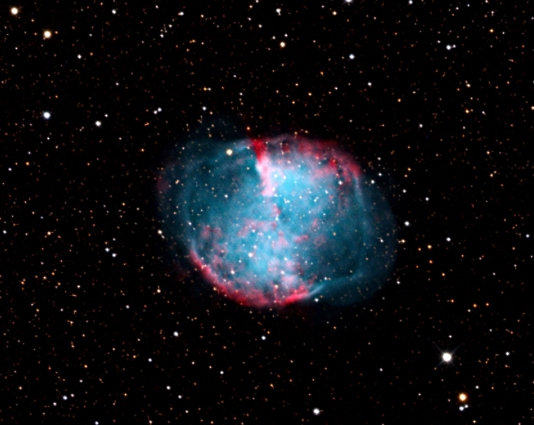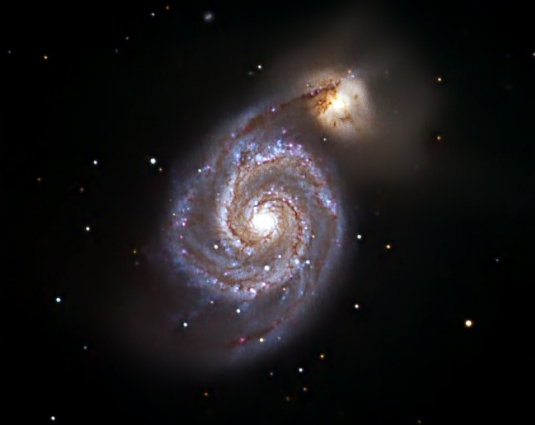

We moved our vacation belongings into our Cabin in the Sky on May 14, which happened to be the day after a new Moon ;). So I prevailed upon Loula and Alexandre to travel up to the Cabin two days early, on May 12, and that night turned out to be clear and dry, a perfect night for first light at the Cabin in the Sky Observatory!
First operation of the equipment meant that alot of "grunt" work had to be done (including my first-ever operation of a mount under TheSky), and I didn't think I was going to have much time, or energy, left after all the setup work, to take any images. But I did my homework very thoroughly in advance, and luckily things went very smoothly, so although it was late by the time I was ready to shoot some test images, I did manage a total of 3/4 of an hour of imaging, and I am very excited at the results (see below)!
My goal that evening was to commission the most important control systems for the telescope, the PlaneWave CDK17, and the mount, the Paramount ME. By the time we drove over from Vancouver, checked out the Cabin, and had dinner, it was nearly 9PM before I started my work at the observatory. First-off was cabling everything together, testing that TheSky could communicate with and synch the mount, followed by a rough manual adjustment of the altitude and azimuth of the mount's polar axis. Next up, and quite time consuming, was getting an improved, but still only provisional, polar alignment of the telescope, using two iterations of TPoint, with the minimum number of stars.
There was still alot of work to be done, including initiating simultaneous control of the mount under the camera control software Maxim DL, as well as the TheSky, and calibration of the auto-guiding and auto-focus software, but with Messier 51, the Whirlpool Galaxy, arcing high overhead at that point (just before 2AM), and being first on my list of deep-sky wonders to image, I decided to go for it. So here is my first-light image with my new gear! This is only 30 minutes of integrated exposure, taken as a series of one-minute shots, 10 in each of the R, G, and B colour filters. These were taken after only a rough focus by visual inspection of a few images of some bright stars in Leo, and *without* auto-guiding! I used 3x3 binning of the SBIG STL-4020M CCD chip, to get bright results in a hurry, giving an image scale of about 1.5" per image pixel. The individual exposures were still too short for this faint object, so streaking due to read noise is visible, despite my best efforts to smooth it away. Image capture and initial processing were done with Maxim DL, with additional processing in Photoshop. I was thrilled that I could get such vivid colours, with the blues in the spiral arms of M51, and the reds in its tidally-disrupted partner NGC5195. The images on this page are cropped to show the central portion of the full frame. Click any image to pop-up the high resolution full-frame version.
For an easier target, I then turned to Messier 27, the Dumbbell Nebula, with its bright and vivid colours, and by that time (almost 3AM) reaching appreciable altitude to the East. This image represents only 15 minutes of integrated exposure, 5 one-minute un-guided shots in each of RGB,again with 3x3 binnning.
Overall, a thoroughly satisfying first night in my new observatory!
The following night, May 13/14, had scattered cloud, but enough stars were visible (including M44 poking through holes in the clouds) that I was able to get the auto-guiding software calibrated (another first for me).
We returned to the Cabin in the Sky the next weekend, for the Victoria Day holiday, and since the gibbous Moon meant that little useful imaging could be done, I concentrated on getting the camera control system and auto-focus software (under MaxIM DL at this point - FocusMax to come) working. It was very satisfying to get the entire control system up and running in just two weekends at the observatory! Although I got the fous software working on the night of May 23/24, and swore that I would concentrate only on calibration of the control systems that night, because of the late setting Moon, I abandoned a thorough testing of the auto-focus to shoot a 20 minute integrated LRGB exposure of Messier 57, the Ring Nebula, sandwiched in between the setting of the Moon and the rising of astronomical twilight. I worked the image processing to bring out the background galaxy IC1296, but I swear that this is the last time I take a short image. From now on, I will devote myself exclusively to many, many hours of LRGB, one object at a time, so I can capture the kind of rich, deep detail that I hope I can bring out of this superb equipment and fabulous location!
CITSO Blog: First light at the Observatory, May 12 2010






























Copyright © 2014 Howard Trottier





